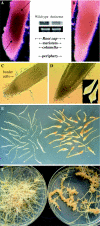Inducible expression of Pisum sativum xyloglucan fucosyltransferase in the pea root cap meristem, and effects of antisense mRNA expression on root cap cell wall structural integrity
- PMID: 18347802
- PMCID: PMC2755773
- DOI: 10.1007/s00299-008-0530-0
Inducible expression of Pisum sativum xyloglucan fucosyltransferase in the pea root cap meristem, and effects of antisense mRNA expression on root cap cell wall structural integrity
Abstract
Mitosis and cell wall synthesis in the legume root cap meristem can be induced and synchronized by the nondestructive removal of border cells from the cap periphery. Newly synthesized cells can be examined microscopically as they differentiate progressively during cap development, and ultimately detach as a new population of border cells. This system was used to demonstrate that Pisum sativum L. fucosyl transferase (PsFut1) mRNA expression is strongly expressed in root meristematic tissues, and is induced >2-fold during a 5-h period when mitosis in the root cap meristem is increased. Expression of PsFut1 antisense mRNA in pea hairy roots under the control of the CaMV35S promoter, which exhibits meristem localized expression in pea root caps, resulted in a 50-60% reduction in meristem localized endogenous PsFut1 mRNA expression measured using whole mount in situ hybridization. Changes in gross levels of cell wall fucosylated xyloglucan were not detected, but altered surface localization patterns were detected using whole mount immunolocalization with CCRC-M1, an antibody that recognizes fucosylated xyloglucan. Emerging hairy roots expressing antisense PsFut1 mRNA appeared normal macroscopically but scanning electron microscopy of tissues with altered CCRC-M1 localization patterns revealed wrinkled, collapsed cell surfaces. As individual border cells separated from the cap periphery, cell death occurred in correlation with extrusion of cellular contents through breaks in the wall.
Figures







Similar articles
-
Pea Border Cell Maturation and Release Involve Complex Cell Wall Structural Dynamics.Plant Physiol. 2017 Jun;174(2):1051-1066. doi: 10.1104/pp.16.00097. Epub 2017 Apr 11. Plant Physiol. 2017. PMID: 28400496 Free PMC article.
-
Cloning of genes whose expression is correlated with mitosis and localized in dividing cells in root caps of Pisum sativum L.Plant Mol Biol. 1997 Dec;35(6):1045-51. doi: 10.1023/a:1005930625920. Plant Mol Biol. 1997. PMID: 9426627
-
Xyloglucan and cellulose form molecular cross-bridges connecting root border cells in pea (Pisum sativum).Plant Physiol Biochem. 2019 Jun;139:191-196. doi: 10.1016/j.plaphy.2019.03.023. Epub 2019 Mar 17. Plant Physiol Biochem. 2019. PMID: 30904720
-
Root genomics: towards digital in situ hybridization.Genome Biol. 2004;5(6):227. doi: 10.1186/gb-2004-5-6-227. Epub 2004 May 27. Genome Biol. 2004. PMID: 15186485 Free PMC article. Review.
-
Interplay between Ions, the Cytoskeleton, and Cell Wall Properties during Tip Growth.Plant Physiol. 2018 Jan;176(1):28-40. doi: 10.1104/pp.17.01466. Epub 2017 Nov 14. Plant Physiol. 2018. PMID: 29138353 Free PMC article. Review.
Cited by
-
Pea Border Cell Maturation and Release Involve Complex Cell Wall Structural Dynamics.Plant Physiol. 2017 Jun;174(2):1051-1066. doi: 10.1104/pp.16.00097. Epub 2017 Apr 11. Plant Physiol. 2017. PMID: 28400496 Free PMC article.
-
Receptor Plants Alleviated Allelopathic Stress from Invasive Chenopodium ambrosioides L. by Upregulating the Production and Autophagy of Their Root Border Cells.Plants (Basel). 2023 Nov 9;12(22):3810. doi: 10.3390/plants12223810. Plants (Basel). 2023. PMID: 38005707 Free PMC article.
References
-
- {'text': '', 'ref_index': 1, 'ids': [{'type': 'PubMed', 'value': '7958328', 'is_inner': True, 'url': 'https://pubmed.ncbi.nlm.nih.gov/7958328/'}]}
- Albersheim P, An JH, Freshour G, Fuller MS, Guillen R, Ham KS, Han MG, Huang J, O’Neil M, Whitecombe A, Williams MV, York WS, Darvill A (1994) Structure and function studies of plant cell wall polysaccharides. Biochem Soc Trans 22:374–378 - PubMed
-
- None
- Barlow PW (1975) The root cap. In: Torrey JG, Clarkson DT (eds) The development and function of roots. Academic Press, London, pp 21–54
-
- {'text': '', 'ref_index': 1, 'ids': [{'type': 'DOI', 'value': '10.1104/pp.51.1.174', 'is_inner': False, 'url': 'https://doi.org/10.1104/pp.51.1.174'}, {'type': 'PMC', 'value': 'PMC367376', 'is_inner': False, 'url': 'https://pmc.ncbi.nlm.nih.gov/articles/PMC367376/'}, {'type': 'PubMed', 'value': '16658281', 'is_inner': True, 'url': 'https://pubmed.ncbi.nlm.nih.gov/16658281/'}]}
- Bauer WD, Talmadge KW, Keegstra K, Albersheim P (1973) Structure of plant cell walls. 2. Hemicellulose of walls of suspension cultured sycamore cells. Plant Physiol 51:174–187 - PMC - PubMed
-
- {'text': '', 'ref_index': 1, 'ids': [{'type': 'DOI', 'value': '10.1104/pp.118.4.1223', 'is_inner': False, 'url': 'https://doi.org/10.1104/pp.118.4.1223'}, {'type': 'PMC', 'value': 'PMC34738', 'is_inner': False, 'url': 'https://pmc.ncbi.nlm.nih.gov/articles/PMC34738/'}, {'type': 'PubMed', 'value': '9847096', 'is_inner': True, 'url': 'https://pubmed.ncbi.nlm.nih.gov/9847096/'}]}
- Brigham LA, Woo HH, Wen F, Hawes MC (1998) Meristem-specific suppression of mitosis and a global switch in gene expression in the root cap of pea by endogenous signals. Plant Physiol 118:1223–1231 - PMC - PubMed
-
- {'text': '', 'ref_index': 1, 'ids': [{'type': 'DOI', 'value': '10.1105/tpc.6.12.1703', 'is_inner': False, 'url': 'https://doi.org/10.1105/tpc.6.12.1703'}, {'type': 'PMC', 'value': 'PMC160556', 'is_inner': False, 'url': 'https://pmc.ncbi.nlm.nih.gov/articles/PMC160556/'}, {'type': 'PubMed', 'value': '12244231', 'is_inner': True, 'url': 'https://pubmed.ncbi.nlm.nih.gov/12244231/'}]}
- Brisson LF, Tenhaken R, Lamb C (1994) Function of oxidative cross-linking of cell wall structural proteins in plant disease resistance. Plant Cell 6:1703–1712 - PMC - PubMed
Publication types
MeSH terms
Substances
LinkOut - more resources
Full Text Sources
Research Materials
Miscellaneous

